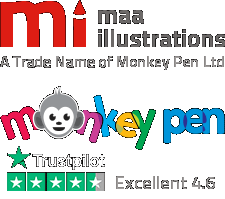Patient empowerment is becoming a key factor in the complex world of healthcare, contributing to better health and outcomes. The tremendous influence of medical illustration, a visual language that cuts beyond the complexity of medical information, is at the core of this empowerment. This article delves into the critical role that medical illustrations play in empowering individuals, promoting a deeper awareness of their health, aiding in informed decision-making, and cultivating a cooperative connection between healthcare providers and the people they serve.
Visualizing the Unseen:
Patients may find it difficult to understand medical disorders because they are frequently invisible to the unaided eye. By converting complex anatomical information, physiological processes, and clinical states into striking illustrations, medical illustrators fill this gap. Patients are better able to understand the subtleties of their diseases and treatment plans thanks to these images, which provide them an accurate picture of their health.
Improved Instruction for Patients:
A key component of empowerment is patient education, and medical illustration is a potent teaching aid. Infographics, animations, and diagrams are some of the visually appealing styles used to simplify complex medical concepts and procedures. By streamlining information and improving memory, this visual method empowers patients to take an active role in their own health.
Informed Decision-Making:
The foundation of patient-centered care is informed decision-making. Medical illustrators aid in this process by producing illustrations that clarify available treatments, possible results, and related risks. With visual insights at their disposal, patients can take a more active role in decisions regarding their care, which promotes their sense of agency and cooperation with healthcare professionals.
Breaking Down Complexities:
Patients may feel overwhelmed by the technical language used to describe medical disorders. Medical pictures serve as translators, converting difficult medical ideas into understandable and relatable visual stories. Patients can better comprehend their diagnoses, treatment regimens, and the anticipated course of their health with the help of this visual storytelling.
Navigating Treatment Plans:
Medical illustration offers patients undergoing complex treatment programmes a road map for what lies ahead. Patients are given the ability to understand and confidently navigate their treatment programmes thanks to the illustrations produced by medical illustrators, which can explain anything from the intricacies of rehabilitation exercises to the workings of pharmaceutical mechanisms.
Using Visualisation to Reduce Anxiety:
Anxiety and uncertainty might be sparked by a medical diagnosis or treatment. By producing images that demystify these experiences, medical illustrators improve the wellbeing of their patients. These images, which may be used to show the stages of a surgery or the effects of a medication, allow patients a concrete understanding and reduce their worry and boost their confidence.
Communication Across Language Barriers:
Communication might be hampered by language issues in our diverse healthcare environment. Medical illustration provides a worldwide visual language that overcomes language barriers. Patients with different language backgrounds are better able to understand medical information, which promotes inclusion and guarantees that important information is not mistranslated.
Promoting Health Literacy:
The basis of patient empowerment is health literacy. By providing information in an approachable and interesting manner, medical illustrations improve health literacy. Visuals contribute to a society where people are informed and empowered to make wise health decisions by effectively and effectively conveying ideas.
Encouraging Proactive Health Management:
Proactive health management is more likely to be practised by patients who are equipped with a visual grasp of their health. In order to promote a culture of prevention and long-term health, visuals that show lifestyle modifications, preventative measures, and early indications of conditions empower patients to take charge of their own well-being.
Building Trust and Understanding:
Relationships in the healthcare industry are built on trust. Medical illustrations promote openness by making medical information visually accessible. When patients are able to see the intended interventions, comprehend any dangers, and recognise the anticipated benefits, they feel more connected to their healthcare professionals. For the patient's peace of mind, this openness lays the groundwork for trust.
Emotional Support:
Receiving a diagnosis can be a very sensitive process. Patients receive emotional support when medical drawings are used in conjunction with compassionate communication. Patients find it easier to manage the emotional difficulties of their health journey when they have a visual understanding of their illness. It opens the door for a holistic approach to healthcare that takes into account both physical and emotional well-being by turning the abstract into something concrete.
Promoting Conversation between Patients and Physicians:
Medical illustrators' images act as catalysts, igniting significant dialogues between patients and healthcare professionals. Equipped with visual aids, patients feel more comfortable requesting explanations and posing queries. This candid discussion strengthens the bond between patients and providers and encourages teamwork in the delivery of healthcare.
In summary, medical illustration is a strong ally in the effort to empower patients. Medical illustrators contribute to the healthcare environment by skillfully transforming medical knowledge into visual narratives that empower patients to take an informed, active, and involved role in their own health. In order to promote a comprehensive and team-based approach to healthcare, medical illustration plays a crucial role as the patient empowerment movement advances.






